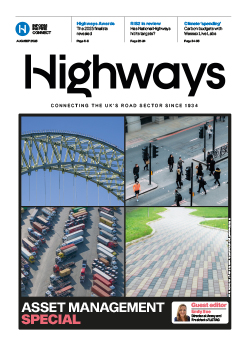Chris Ames asks whether guidance on the traffic calming is keeping up with the latest thinking.
Somerset County Council has ‘refreshed’ its technical advice note on the subject of traffic calming, to draw attention to the range of measures available to developers, designers and other stakeholders on its roads.
The advice note states that the subject is too vast and wide-ranging for a single document to cover every aspect and is not intended to be prescriptive. Nevertheless, it runs to over 100 pages.

The document defines the primary objective of traffic calming as ‘to produce a road network that is driven calmly, smoothly and safely by motorists, at speeds which are appropriate to the local environment taking into consideration the presence of other vulnerable road users’.
It adds that traffic calming aims to change motorists’ behaviour and ‘to civilise the car’.
The council tells Highways that the document arose both from a feeling that the national guidance – a 2017 local transport note (LTN 1/07) – was a little out of date and because it found there was a need for some local guidance to reflect the rural nature of the county.
Richard Hayes, chief executive of the Institute of Highways Engineers, agrees. He tells Highways: ‘I think the advice note is a bit dated, with less traffic calming being installed to standard layout and many more local solutions being introduced.
‘Many authorities include their standards in the planning development guidelines and the developers are building them into new housing projects.’
This of course reflects the reality that many new road areas in residential areas – ie the areas where traffic calming is most likely to be considered – are constructed by developers before being adopted by highway authorities.
The Department for Transport (DfT) says it has no plan to update LTN 1/07, which it says gives guidance on all types of traffic calming, and remains valid.
While it sees traffic calming features as an effective way to reduce speed it says it is for local authorities to determine where and what type of features they install. Somerset CC told Highways that it recognises the value in promoting traffic calming schemes where a proven need is identified and that although it seeks to facilitate development opportunities, it is important promoters base their proposals on relevant standards, guidance and best practice.
A spokesperson says that while a variety of design standards, legislation and best practice has been written on the subject its guidance ‘is intended to assist the works promoter by signposting them to the relevant information required to support their design proposals and to ensure they reflect local needs’.
The council’s guidance highlights that the term traffic calming first came into common technical use around 1990, around the same time the power to introduce 20mph limits with ‘suitable traffic calming measures’, also came in.
Certainly the two are closely linked, not just in the controversy they provoke.
A 20mph zone, as opposed to a simple 20mph limit, is required to include a single physical traffic calming measure to produce ‘self-enforcement’.
Simon Morgan of Buchanan Computing, who teaches courses on these issues, suggests that since the extra flexibility brought about by the Traffic Signs Regulations and General Directions (TSRGD) 2016 the traffic engineering judgement over whether to choose a zone or a limit should begin with a decision over the physical traffic calming measure or measures.
He advises that if one is felt to be needed an authority may well wish to pursue a zonal system, however if a physical calming measure is not the main priority, councils can save time and costs by simply putting in a 20mph speed limit.
The DfT points out that the 2016 revision of the TSRGD permitted authorities to use 20mph repeater signs as a form of traffic calming feature in a 20mph zone, which is required to have such features no more than 100 metres apart. A minimum of one physical feature must still be present.
The TSRGD states that the move ‘will enable local authorities to reduce the number of physical traffic calming features where vehicle speeds are already around 20mph due to the nature of the road’.
However, this tendency for 20mph zones to lose the reliance on the physical features that define them seems to go against the grain of recent research suggesting sign-only 20mph zones have very limited effects on speed.
In relation to the option of using mainly signing (whether on vertical signs or on-road markings) within 20mph zones the Somerset guidance adds a reminder that ‘physical traffic calming measures will be more effective in reducing the speed of vehicles than purely relying on [signing]’.
Mr Hayes says: ‘Engineering the road layout is always the most effective way of reducing speeds.’





